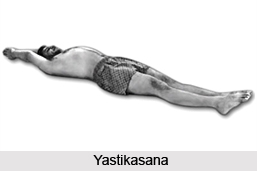 Yastikasana is a cultural yoga asana that involves an upward stretch of the whole body. It is part of the upward stretching asanas; that improve muscle coordination and synchronisation. The asana also steps up the body`s usage of fat reserves. It can bring about a small increase in the practitioner`s height and exercises the muscles of the neck, back and upper limbs.
Yastikasana is a cultural yoga asana that involves an upward stretch of the whole body. It is part of the upward stretching asanas; that improve muscle coordination and synchronisation. The asana also steps up the body`s usage of fat reserves. It can bring about a small increase in the practitioner`s height and exercises the muscles of the neck, back and upper limbs.
Meaning of Yastikasana
Yastikasana translates to the stick pose in Sanskrit as the finished, fully stretched posture resembles a stick lying on the ground.
Practice of Yastikasana
A sequential process for performing Yastikasana follows
* Lie on your back with legs fully ex
tended and arms stretched out towards the head. Be at ease and relax.
* Inhale for 3 seconds, and while retaining the breath, stretch the body at full length slowly and carefully with toes and fingers pointing outwards. Maintain this stretch for six seconds.
* Release the tension of the stretch while exhaling. Make sure you stretch only while holding your breath.
The full length stretch of the body is called Yastikasana
Effects of Yastikasana
Yastikasana alleviates the harm done by incorrect body postures and gently exercises the abdominal and pelvic muscles, and can also increase one`s height to small extent thanks to the intense stretch.
It exercises the muscles of the upper limb and the neck, back and the inner walls of the abdominal region.
Precautions in the practice of Yastikasana
Practitioners must ensure that they must not stretch while exhaling, and to not stretch too intensely, instead increasing it gradually, with each subsequent attempt.
Yastikasana is arguably a simpler variant of the Talasana, which essentially involves the same pose performed while standing, thus stretching against gravity. Yastikasana provides similar benefits without the effort of straining against one`s own weight, and provides a healthy stretching exercise to the whole body.
This article is a stub. You can enrich by adding more information to it. Send your Write Up to content@indianetzone.com




















